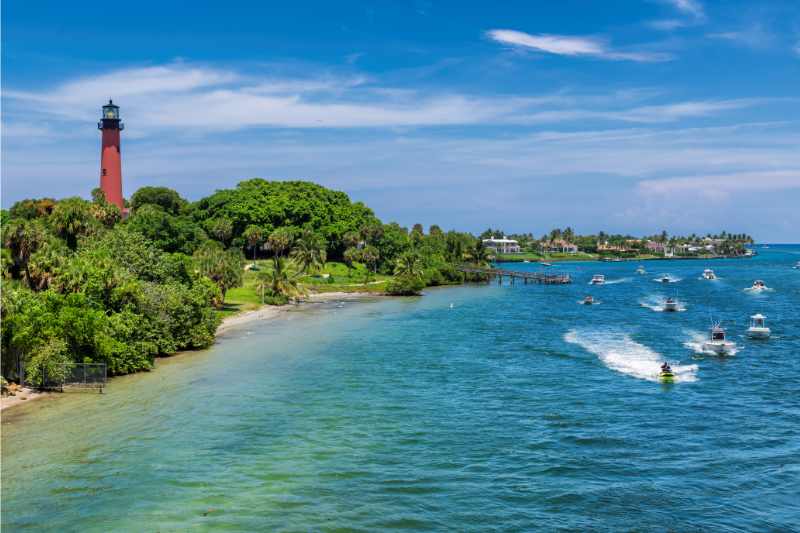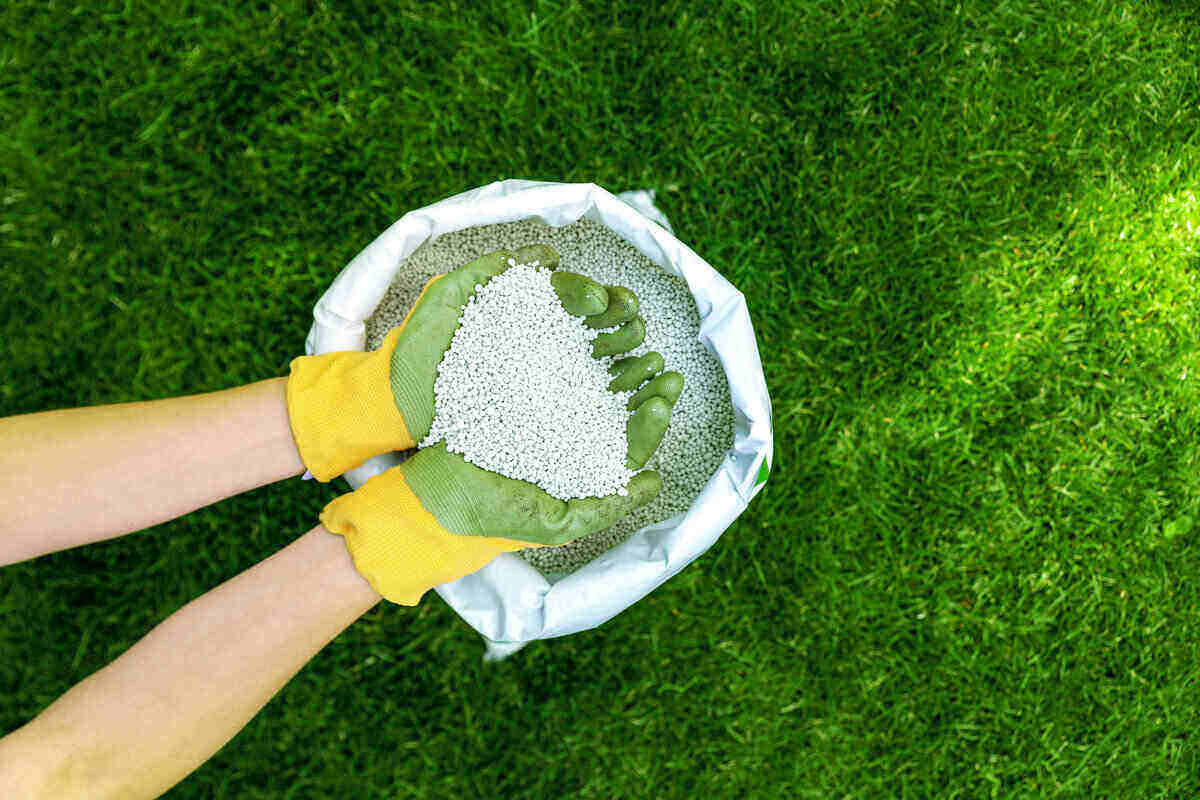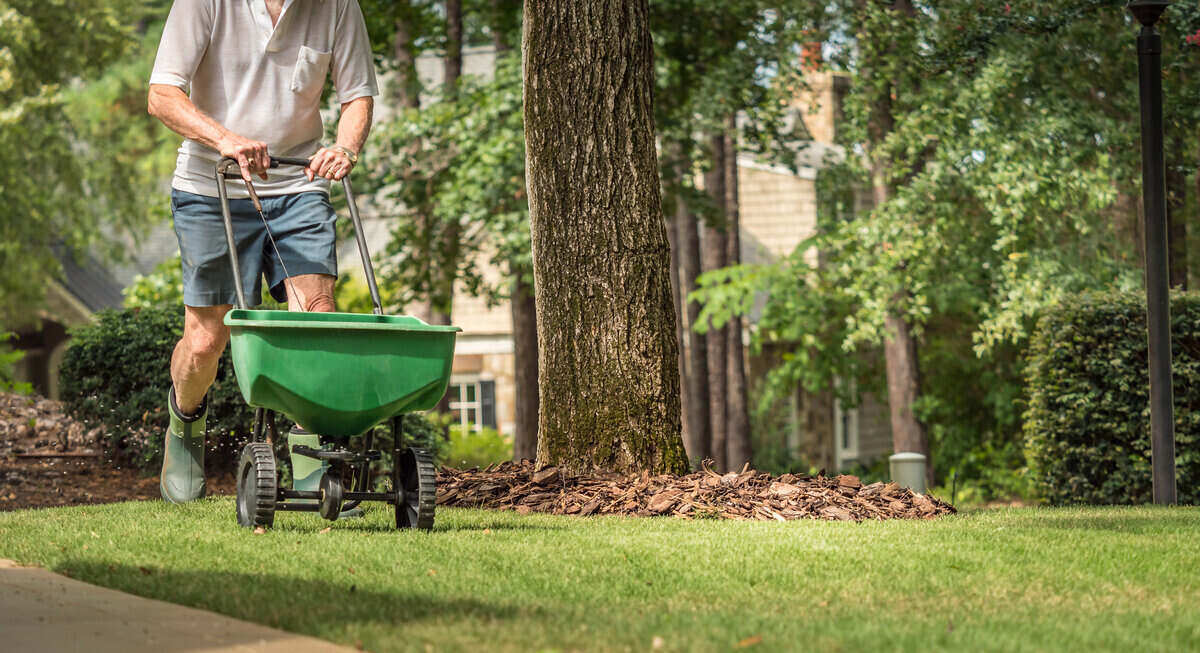
If you’re apt to pull the trigger on a bottle of weed and feed and launch an all-out chemical assault at the first sign of a dandelion, you might soon be forced to put down your weapon. A growing number of cities are banning synthetic fertilizers and pesticides.
Across the United States, cities are increasingly imposing lawn chemical restrictions on municipal properties, and in some cases, these bans are expanding to include residential properties.
The Toxic Troubles of Lawn Chemicals
We don’t often think beyond the price tag of a bag of fertilizer or the bill we receive from our lawn care company, but growing a lush, green lawn comes at a much more extensive cost. Commonly used lawn chemicals have been linked to various health issues ranging from allergies and skin irritation to congenital disabilities and cancer.
While chemical fertilizers and pesticides pose direct concerns to human health through exposure, their biggest concern is their environmental impact when misapplied to lawns. Inappropriate or overapplication of these products can result in runoff that carries excessive nutrients or toxic chemicals into streams, ponds, lakes, and groundwater sources, contaminating waters and harming wildlife.
Landscape chemicals also can cause air pollution and soil erosion and decrease biodiversity.
Of the 30 commonly used lawn pesticides:
- 23 can leach into drinking water sources
- 17 are widely detected in groundwater
- 24 are toxic to fish and other vital aquatic organisms
- 11 are toxic to bees
- 16 are harmful to birds
The widespread availability of synthetic fertilizers and pesticides has led to consumer complacency.
People often think that just because a product is available for sale online or on a store shelf, it’s safe for use, but that isn’t always the case. There needs to be a healthy awareness of the dangers all chemical products pose, and they should be used judiciously, if necessary.
Unfortunately, it isn’t an easy or small problem to tackle. The amount of fertilizers and pesticides applied to US lawns and landscapes is eye-opening. Homeowners apply a staggering 90 million pounds of pesticides to their lawns and gardens annually!
However, awareness is changing across the United States and worldwide, impacting how we care for our lawns.
Note: In this article, the term “pesticide” encompasses all products used to control insects, weeds, diseases, and other pests — not just insects, as one might think. Local ordinances may refer to products by a more specific name that indicates what the chemical treats: insecticide (insects), herbicide (weeds), fungicide (fungi), or rodenticide (rodents).
US Cities Limiting Lawn Fertilizers and Pesticides
As environmental and human health concerns grow nationwide, cities enact strict regulations or pass bans on synthetic lawn chemicals to protect citizens and local water sources.
Concerns over pollution, including toxic algae blooms that are killing aquatic life, have also led more than 30 Florida counties to enact strict regulations that range from establishing fertilizer-free zones within 25 feet of ponds, streams, wetlands, and other waterways to testing plant tissues before applying phosphorus.
Ogunquit, Maine

On November 4, 2014, a ballot initiative was passed by Ogunquit residents to ban toxic pesticide use on landscapes and lawns within the town’s jurisdiction. Chemical pesticides classified by the US Environmental Protection Agency as exempt materials under 40 CFR 152.25, and products permitted by the Organic Materials Review Institute are allowed.
Montgomery County, Maryland
In a groundbreaking move in 2015, Montgomery County banned pesticide use on residential lawns. It was one of the country’s strongest lawn pesticide regulations at the time.
The pesticide industry quickly challenged the ban, but the Maryland Supreme Court upheld the county-wide law in 2019.
Boulder, Colorado

(Beyond Pesticides, May 6, 2015) The City of Boulder, Colorado, restricted using bee-toxic neonicotinoid (neonic) pesticides on city property in May 2015. The resolution was primarily propelled by efforts of grassroots activities with the local Bee Safe Boulder organization but also received strong support from Boulder officials.
“We at Bee Safe Boulder, along with city staff and elected city council members, believe that this resolution will become the go-to template for other local governments with similar aspirations in the near future,” said David Wheeler, co-founder of the Bee Safe Boulder local group.
Portland, Maine

In January 2018, Portland, Maine, was one of the first cities to pass a profound ban that became national news. Portland’s pesticide use ordinance prohibits using weed and feed products that combine fertilizers and pesticides, Roundup® and other weed killers containing the active ingredient glyphosate, and insecticides with a neonicotinoid called imidacloprid.
The city still allows products “acceptable for organic use” or Organic Materials Review Institute (OMRI) certified. Failure to comply with the ban could leave homeowners facing up to $500 in fines.
“Education is making a big difference,” says Avery Yale Kamila, co-founder of Portland Protectors, a nonprofit environmental group in Maine. “The more people learn about the health and environmental impact of synthetic pesticides and fertilizers, the more they want to make different choices.”
Jupiter, Florida

In 2019, Jupiter banned pesticides and fertilizers during the rainy season to protect the Loxahatchee River and address algal blooms. Between June 1st and September 30th—what is known as the blackout season—only properly trained and licensed contractors and homeowners are allowed to apply fertilizer or pesticides.
Slow-release fertilizers with no phosphorus are the only types permitted during this time.
Baltimore, Maryland

Limitations regarding applying and using glyphosate, chlorpyrifos, and neonicotinoid pesticides on all city-owned properties were approved in 2020.
Baltimore City Council Bill 20-0495 took effect July 1, 2022, prohibiting the use and application of glyphosate, chlorpyrifos, and neonicotinoids on residential lawns, playgrounds, mulched recreation areas, children’s facilities, and playing fields.
Maui, Hawaii

In August 2021, the Maui County Council voted unanimously to pass Bill No. 72, which allows only pesticides and fertilizers permitted under the USDA National Organic Program to be used on all county properties.
Norwalk, Connecticut

Norwalk’s city council approved a new ordinance in July 2022 banning non-organic pesticides on all city-owned properties. According to Drew Toher, community resource and policy director for Beyond Pesticides, the umbrella term “pesticides” includes “insecticides, herbicides, fungicides, rodenticides, all the other biocides out there intended to mitigate, kill or repel a pest or weed.”
Exceptions to the ordinance include certain extreme situations, such as persistent poison ivy on school properties, provided the application area is not within 200 feet of any surface waters.
Hallowell, Maine

Hallowell’s city council voted unanimously in September 2023 to pass a pesticide ban stopping residents from using pesticides on private properties. The ban also includes provisions for water testing to detect the presence of pesticides and fertilizers in town waters. The legislation went into effect in January 2024.
Backlash on Bans
Obviously, legislation limiting the use of lawn chemicals is bound to be contested by manufacturers, landscaping professionals, and even some homeowners.
Although companies that manufacture banned neonicotinoids and glyphosate products have not made public statements about the ever-increasing number of cities enacting strict regulations (or outright prohibitions) on these ingredients, their websites reassure consumers their products are safe for use.
Regarding glyphosate, Bayer — the manufacturer of the muchly contested herbicide Roundup® — writes, “Glyphosate is one of the most studied herbicides in the world – and, like all crop protection products, it is subject to rigorous testing and oversight by regulatory authorities. There is an extensive body of research on glyphosate and glyphosate-based herbicides…that confirm that glyphosate and our glyphosate-based formulated products can be used safely and are not carcinogenic.”
Lawn care and landscaping companies are some of the most vocal opponents of these bans.
After all, chemical limitations severely limit their practices and impact how effectively they do their jobs. More and more organic products are available, but they typically come at a higher price and don’t always work as well as conventional lawn care chemicals, especially with tenacious weeds.
The challenge is that lawn care professionals don’t have the same ability to achieve the results they once did with synthetic products, but their customers expect the same results.
Per Brandon Sheppard, owner of a Weed Man franchise in Montgomery County, Maryland, “Many of the products that are allowed for weed control and pest control are just simply not very effective and so you have increased cost of the material, reduced effectiveness and a massive jump in the labor required to deliver the service because of the number of reapplications you have to do with a less comparable product.”
In a 2018 Lawn & Landscape’s State of the Industry report, 29% of landscape and lawn care companies were very concerned about bans impacting their businesses. One operator said bans have made it harder to treat certain weeds, which makes it more difficult to meet homeowner expectations. He added, “Even clients who are purely organic get tired of the results sometimes.”
Improvements Seen By Limiting Fertilizer and Pesticide Use

The bans are so widespread now that many fertilizer companies no longer include phosphorus in most of their fertilizer products because of the damage phosphorus poses to water. Which is generally okay when it comes to lawn fertilizers.
Most soils typically have enough phosphorus that additional nutrient supplementation isn’t needed. Fertilizers formulated for new lawns and gardens still contain P, but these products are intended for short-term use and pose fewer concerns.
And there’s no doubt that limiting lawn chemical use or ensuring correct application can bring about positive environmental changes.
Studies show that chemical bans can help the environment. Researchers at the University of Michigan found that phosphorus levels in the Huron River dropped by 28% after the city of Ann Arbor adopted a fertilizer ban.
How to Use Lawn Chemicals Safely
- Always follow label directions for application rates and timing.
- Routinely run a soil test to determine your soil’s fertility and apply lawn fertilizer based on the results.
- Avoid applying lawn fertilizer between November 15 and March 1 when the grass is dormant.
- Only use the type and amount of fertilizer your lawn needs.
- Avoid applying pesticides right before rain.
- Do not apply pesticides close to stream banks, ponds, etc.
FAQ About Cities Limiting Lawn Fertilizers and Pesticide Use
How Long are Pesticides and Herbicides Toxic on Grass?
Whether you spray products yourself or hire a professional to do it for you, it’s recommended that humans and pets stay away from treated areas for anywhere from six to 24 hours. A general recommendation is to wait at least until the product has dried completely.
However, a 2013 research study examining lawn pesticide levels in dog urine found that herbicides persisted on lawn surfaces for more than 48 hours after application.
Are Organic Fertilizers and Pesticides Effective?
Organic fertilizers and pesticides might not work as quickly or effectively as synthetic products, but they can feed your lawn and control pests. The fertilizers are usually comprised of slow-release nutrients, so they feed your lawn over time, taking longer to see results. Organic pesticides work through different modes of action—typically drying out the plant or insect—so they also work slower and may take numerous applications.
Can I Have a Healthy Lawn Without Using Harmful Pesticides?
Yes! You don’t have to choose between having a lush, green, healthy lawn and a healthy home and planet. Many integrated pest management practices and organic pesticide options that significantly reduce or eliminate synthetic chemicals are available.
Pro tip: Need help with organic herbicide options? Lawn Starter has a helpful guide on organic weed killers.
Need Help Navigating Limitations on Lawn Chemical Use?
The truth is, we’re likely to see more cities and states enact legislation regarding lawn chemical use as environmental concerns continue to grow.
If you’re facing already-enacted restrictions or there’s talk about imminent changes coming to your area, let Lawn Starter help! We will connect you with local lawn care professionals equipped with the tools to keep your lawn lush and green, even with limitations in place.
Main Image Credit: macniak / Canva Pro / License




